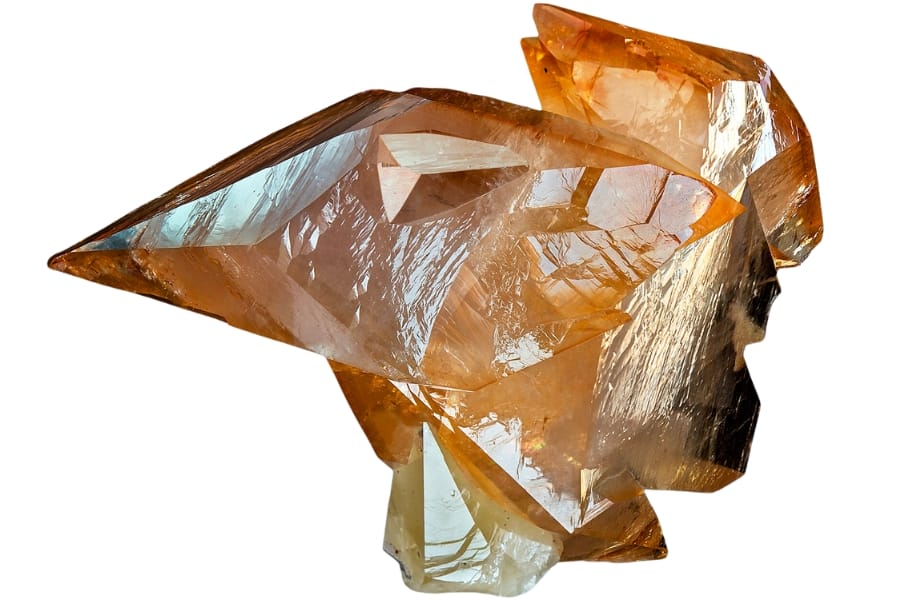Iowa, often celebrated for its lush farmlands and charming small towns, is also a hidden gem for rockhounds. The beauty and variety of the different types of rocks found in Iowa hold a universal appeal, drawing in everyone from curious beginners to seasoned rockhounds.
As you delve into the world of rocks and minerals found in Iowa, it’s impossible not to be captivated by its sheer diversity.
Landmarks like the Devonian Fossil Gorge, Maquoketa Caves State Park, and the Keokuk area along the Mississippi River, stand as testaments to this geological bounty.
Whether you’re a resident or a visitor, our state offers a fascinating, accessible journey into the natural world. Join us as we get to know the common geological treasures that you can find here.
A List of The Common Rocks, Stones, and Minerals Found in Iowa
Iowa’s wide variety of rocks, minerals, gemstones, and crystals is simply captivating. If you’re planning on visiting here and finding them in the wild, we’ve created several comprehensive guides that can help you:
Iowa Rock, Mineral, and Gem
Among the common finds in our state is our official state rock, which captures the interest of rockhounds from everywhere.
| Iowa State Rock | Geode |
As an important reminder, before you head out or start your exploration here, make sure to review Iowa’s local collecting guidelines. It’s crucial to practice sustainable rockhounding to ensure that our future generation will also get to enjoy this activity.
For more information on this, you may visit and consult with the Iowa Department of Natural Resources (DNR) website.
Always Confirm Access and Collection Rules!
Before heading out to any of the locations on our list you need to confirm access requirements and collection rules for both public and private locations directly with the location. We haven’t personally verified every location and the access requirements and collection rules often change without notice.
Many of the locations we mention will not allow collecting but are still great places for those who love to find beautiful rocks and minerals in the wild without keeping them. We also can’t guarantee you will find anything in these locations since they are constantly changing.
Always get updated information directly from the source ahead of time to ensure responsible rockhounding. If you want even more current options it’s always a good idea to contact local rock and mineral clubs and groups
Geode
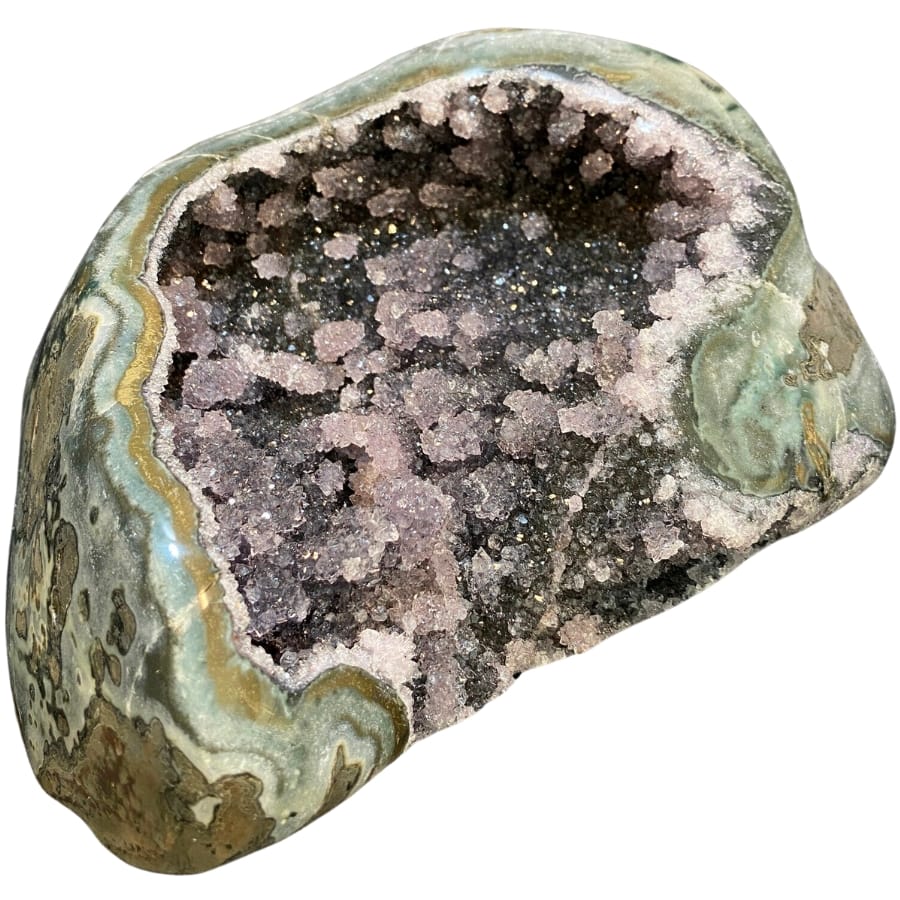
Geodes are like nature’s surprise egg! They’re plain and rocky on the outside but hold a magical world inside. Imagine cracking open a rock and finding it lined with shiny, sparkling crystals— that’s exactly what a geode is.
It forms when the outer shell of a rock creates a hollow space inside. Over time, mineral-rich water seeps into this space. As the water evaporates, it leaves behind minerals that slowly grow into crystals.
The type of mineral determines the color and shape of the crystals, which is why each geode is unique.
In Iowa, you can find different kinds of geodes, including the famous Keokuk geode. It often has captivating crystals inside, like quartz that can be clear, smoky, or even amethyst.
Geode’s value is due to many reasons. They’re natural works of art, each one different from the next. They’re valued not just by scientists and collectors, but by anyone who loves the beauty of the natural world.
Where you can find geode in Iowa
Geodes are widespread in Iowa, and among the best places where you can find them here are:
- Keokuk Geode Beds
- Countywide in Des Moines County
- West Fork Cedar River
Chert
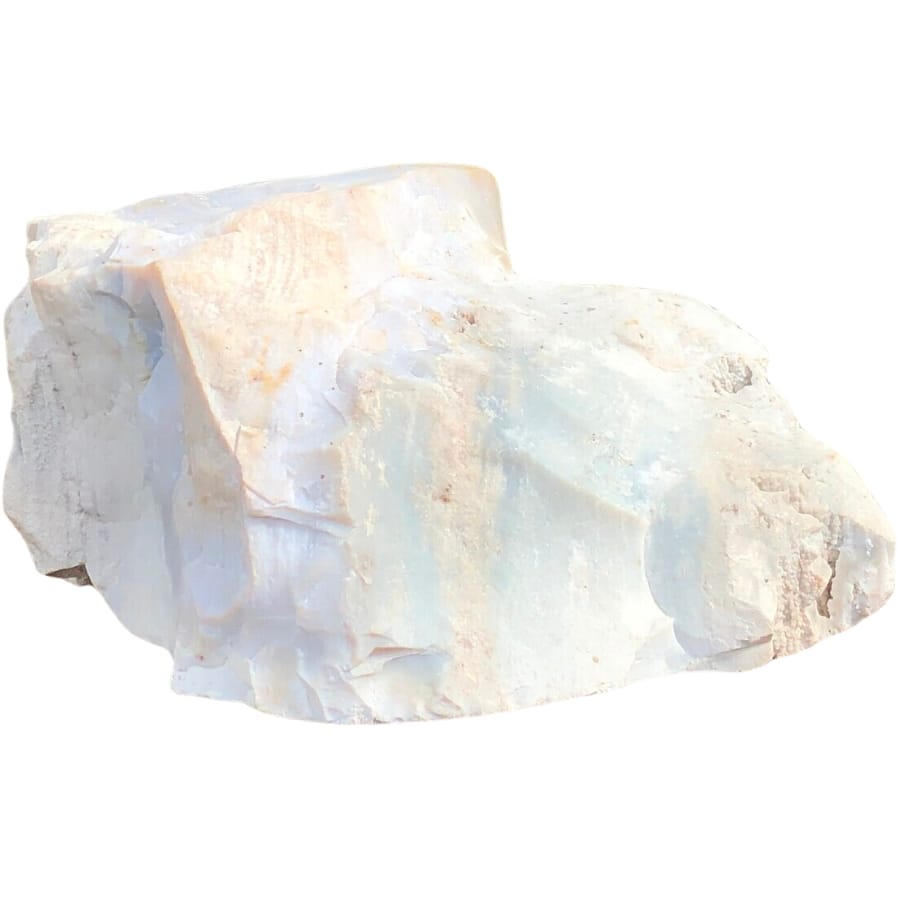
Chert is a hard, fine-grained rock that can be found in a bunch of different colors like white, gray, black, or even red and green. It’s mostly made of tiny pieces of quartz.
This rock often starts forming at the bottom of oceans, lakes, or other bodies of water. Over millions of years, tiny pieces of silica from the water settle down and start to stick together.
As more and more of these pieces pile up and get squished together, they turn into solid chert. Sometimes, you can find chert in strange shapes or even in layers within other types of rock.
Long ago, people figured out that chert breaks with a sharp edge. So, they used it to make tools and weapons like knives, arrowheads, and scrapers. It was like the Swiss Army knife of the ancient world!
Even today, chert is valued for its beauty and its place in history. Rock collectors love it for its different colors and patterns. Scientists study chert to learn about what the environment was like when it formed.
Where you can find chert in Iowa
You can find stunning gem-quality chert specimens if you explore Mount Pleasant and the Red Oak area limestone quarry.
Galena
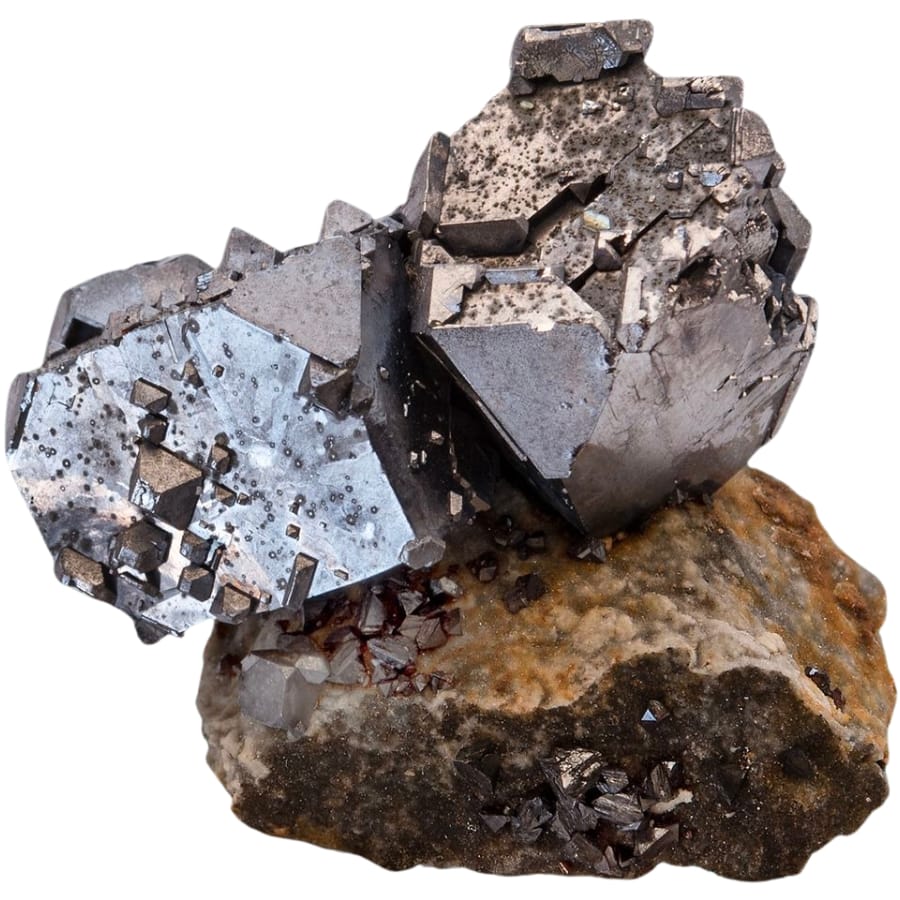
Galena might not be as famous as gold or diamonds, but it has its own story. It’s the main source of lead, and it usually looks like shiny, metallic gray cubes or clusters of cubes. It’s heavy for its size because it’s made mostly of lead.
It starts forming deep underground in places where there are hot fluids moving through the rocks. These fluids have lots of different minerals dissolved in them. When they cool down, the minerals start to come out of the fluid and form crystals.
Over a long time, these crystals grow and become galena. This rock forms in places where there’s a lot of sulfur and lead in these fluids.
As for its value, galena has been mined for a long time because it’s the most important source of lead, a metal that we use in a lot of different things like batteries, bullets, and even pencils and paint in the past.
But it’s not just about the lead. Galena sometimes also contains silver, which makes it even more valuable.
Where you can find galena in Iowa
Among the spots you can explore if you want to find galena in our state are the area mines of New Albin and the quarries and mining dumps in Clayton County.
Limonite
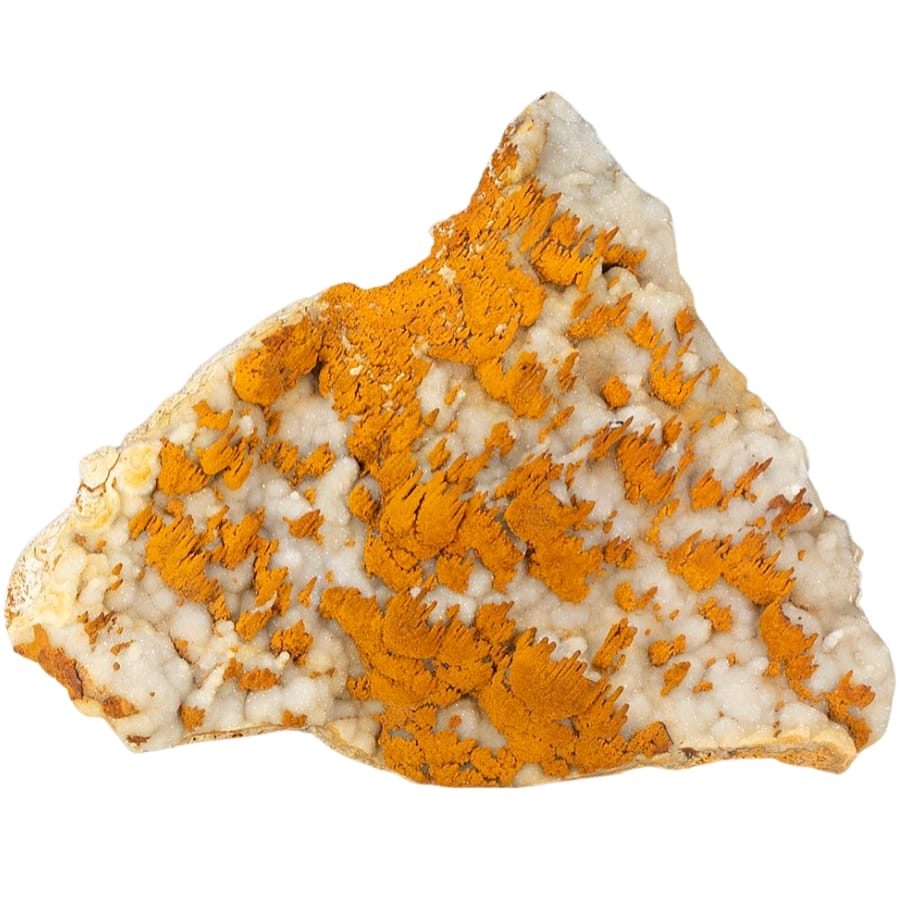
Limonite is actually not a single mineral but a mixture of different iron oxides and hydroxides. It can be different colors like yellow, brown, or even rusty red, and it often looks like a sort of rocky mud or clay.
It’s usually found in places where iron-rich rocks have been changed by water and oxygen. This can happen in a lot of places, like swamps, lakes, or areas with a lot of groundwater.
Limonite is also often found in areas where there used to be mines because the mining exposes the iron minerals to air and water.
The value of limonite comes from a few different things. First off, it’s an important source of iron, which is a metal we use for a lot of stuff, like making steel for buildings and cars.
Limonite is also used in paint pigments and as a coloring agent in pottery. Rock collectors like this mineral because it can form unique shapes and patterns, and its different colors can be quite beautiful.
Where you can find limonite in Iowa
To find limonite, here are some specific spots that you can visit in our state:
- Skunk River gravels
- Quarries and mining dumps in Clayton County
- In geodes from Keokuk
Dolomite
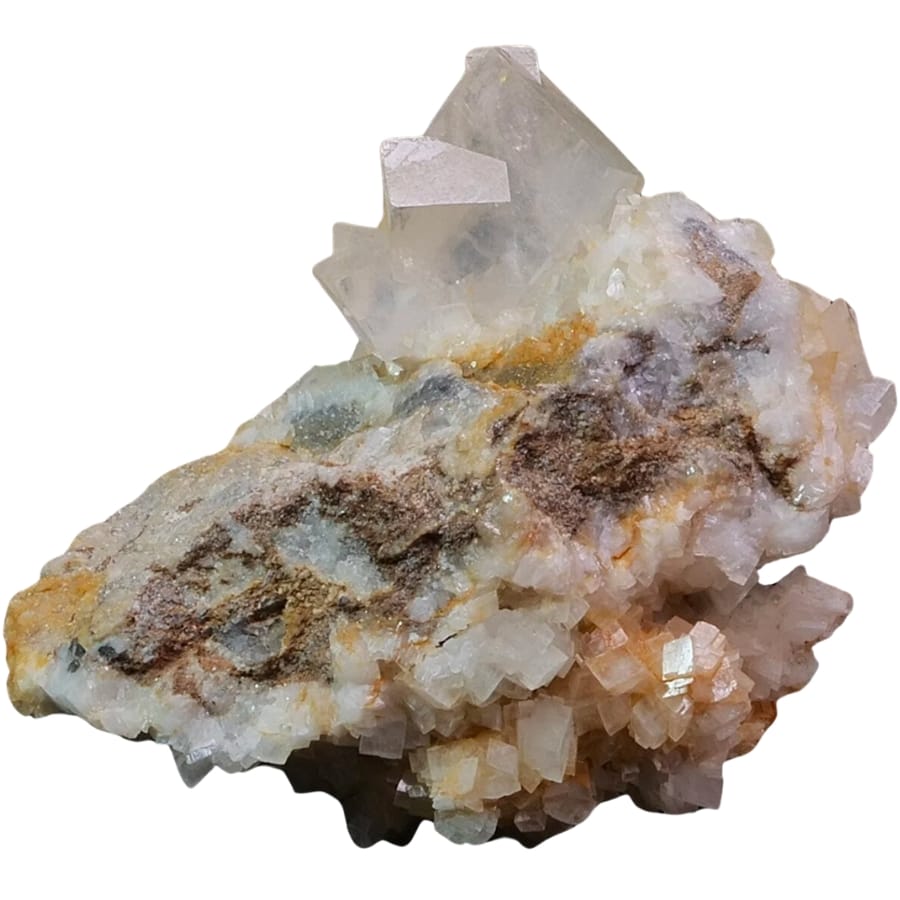
Dolomite contains calcium, magnesium, carbon, and oxygen. It can be different colors like white, gray, pink, or even light brown, and it often has a kind of grainy or sugary look.
This rock can form in a couple of ways, but one common way is through a process that happens in shallow seas. When limestone, which is mostly made of the mineral calcite, is under the water, magnesium-rich water can seep into it.
Over time, this water changes the calcite in the limestone into the mineral dolomite. This process is called “dolomitization,” and it turns the limestone into dolomite rock.
When it comes to the worth of dolomite, it’s valued for a bunch of reasons. It’s used to make concrete and asphalt, both important for building roads and buildings. It’s also used in agriculture to help neutralize acidic soils.
Dolomite is also a key part of certain landscapes. It weathers or breaks down differently than other rocks, creating unique landforms like steep cliffs and deep valleys. This makes dolomite areas really beautiful and important for tourism and nature conservation.
Where you can find dolomite in Iowa
If you’re in search of dolomite, there are a handful of places you can explore for it, such as:
- Oskaloosa area coal mine dumps
- Countywide in Marion County
- Pershing Mine Dump
Goethite
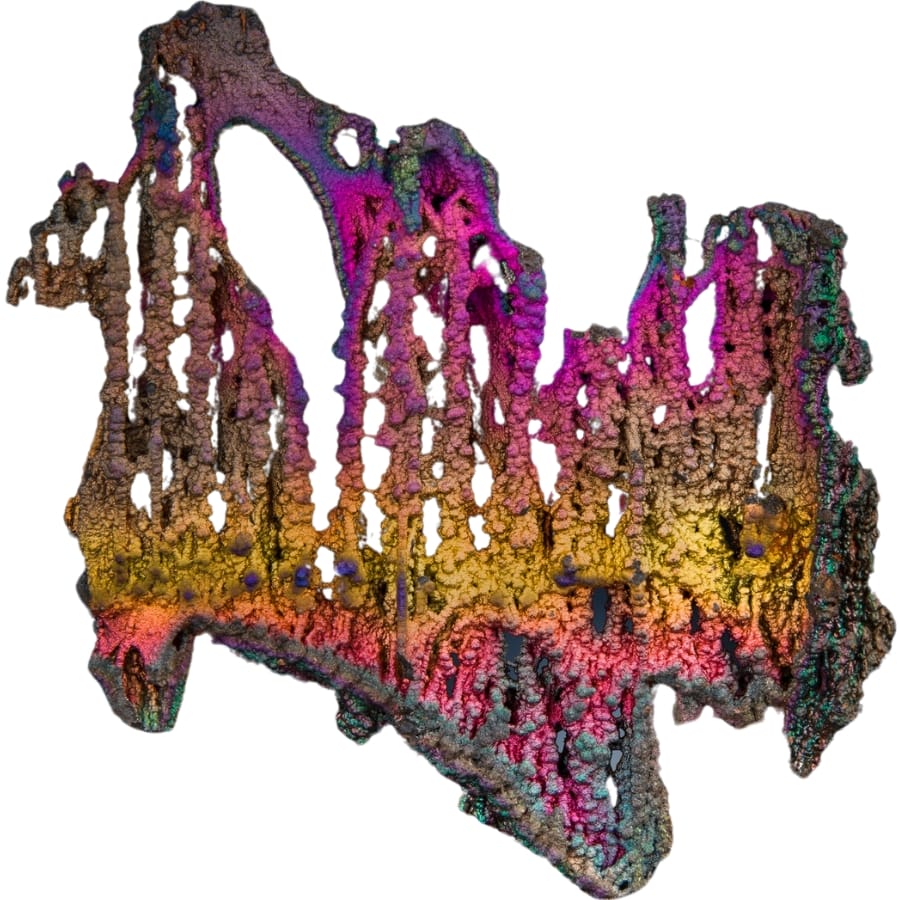
Goethite is an iron oxide mineral, which means it’s made from iron and oxygen. It often has a brownish or yellowish color. It can also have velvety or needle-like crystals, or even a bunch of small, shiny, black rocks.
It often forms in places where there’s lots of water and iron. If you have iron-containing minerals or rocks, and they get exposed to water, they can start to rust. This rusting process can create goethite.
Goethite can also form in soils, in bogs, and as a result of volcanic activity.
It’s also valuable for a few different reasons. Goethite is an important source of iron, a metal we use all the time for making steel that’s used in buildings, cars, and all sorts of other things. So, mining goethite for iron is a big deal.
Plus, because goethite can form in so many different ways, each specimen can look unique from one another. This makes it a popular mineral for collectors who love its variety and the way it looks.
Where you can find goethite in Iowa
This unique-looking mineral can be found in many areas of our state, including:
- Lovilia area coal mine dumps
- Melrose area coal mine dumps
- Tyrone area coal mine dumps
The Gemstones Found In Iowa
Aside from rocks and minerals, there are also bountiful deposits of different gemstones found in Iowa. To help you locate them, you can check out this comprehensive guide:
Agate
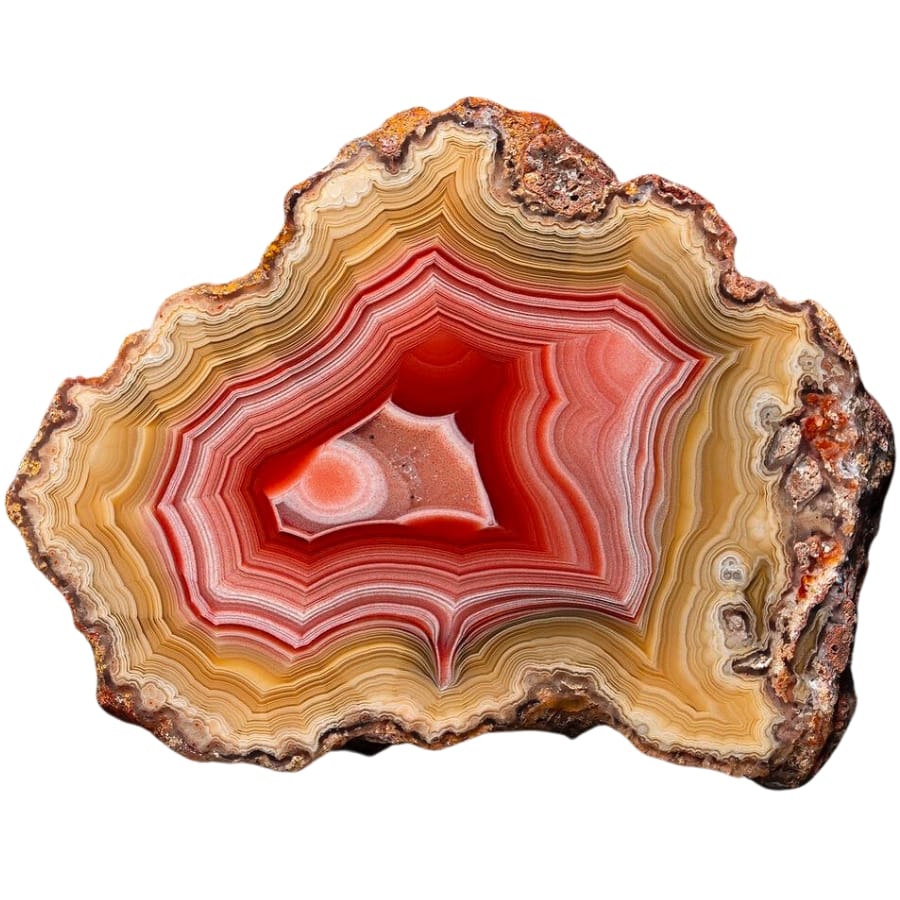
Agate is a kind of quartz that’s renowned for its amazing patterns and colors. It can have stripes, swirls, or spots in all kinds of colors like red, blue, green, or even purple. These patterns make every piece of agate unique, like a natural piece of art.
Its formation usually happens in volcanic rocks or ancient lava flows. When cracks or holes in these rocks get filled with mineral-rich water, layers of quartz start to form inside these spaces.
These layers build up over a long time, and the different minerals in the water give each layer different colors and patterns. That’s how you get the stripes in agate.
You can find this gem in areas where there used to be volcanic activity or where there are old lava flows. Each region can have its own types of agate with unique patterns and colors.
Agate’s value is influenced by many factors, including how we use it. It’s pretty to look at and its colors and patterns can be stunning. That’s why people use it to make jewelry, like necklaces and rings, or decorative items.
Where you can find agate in Iowa
Agate is very abundant in our state and you can find it in a ton of places, such as:
- Countywide in Bremer County
- Countywide in Benton County
- Countywide in Black Hawk County
Jasper
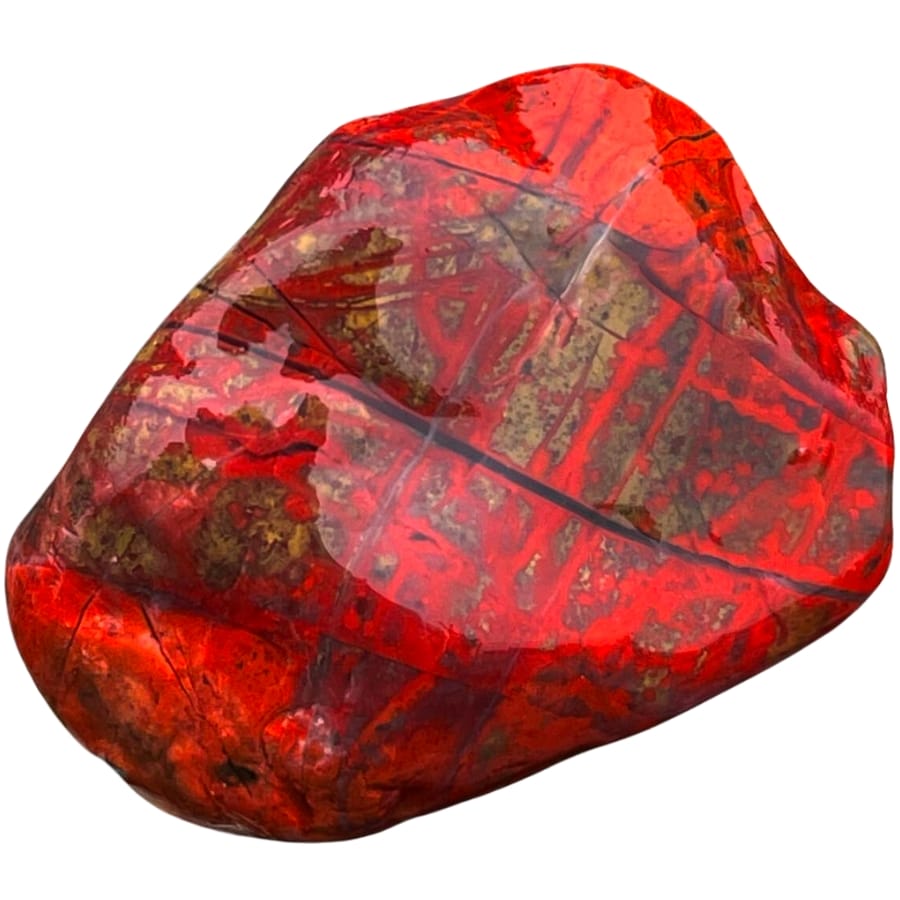
Jasper, another type of quartz, is known for being colorful and having all sorts of patterns. You might see it in reds, yellows, browns, and greens, often with streaks or spots that make it look like a painting.
It starts to grow when silica-rich sediment or volcanic ash gets mixed with other minerals. This mixture then hardens over time, turning into jasper. The different minerals and the way they mix give this gem a variety of colors and patterns.
Jasper can be found in many places around the world, often in areas where there were once hot springs or volcanic activity. It forms in layers and can be found in nodules or as fillings in cracks and gaps in other rocks.
Talking about jasper’s price, it’s valued for a bunch of reasons. It’s really pretty and unique, and its different colors and patterns make it a favorite for jewelry and decorative items.
But jasper is not just about looking good. It’s also interesting for people who study rocks and minerals. Rock collectors and hobbyists also value this gem because finding and identifying its different types can be like an exciting puzzle.
Where you can find jasper in Iowa
Just like agate, jasper is also abundant in our state. Below are just some of the areas you can explore for it:
- Turkey River
- Northern Gravel Company
- Burlington area gravel-dredging operations and gravel pits
Gypsum
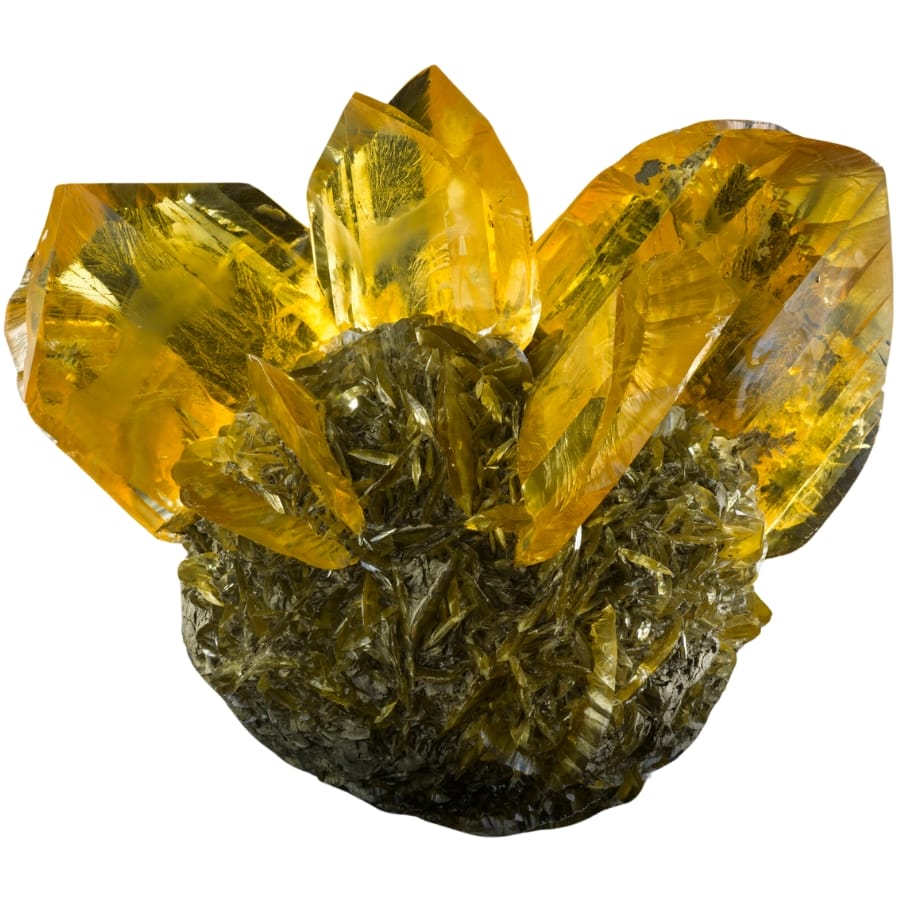
Gypsum is more common than you might think. It’s made from calcium sulfate and water. It can be clear, white, or even have a slight color like pink or yellow, and it’s known for being soft compared to other gems.
The formation of gypsum usually happens in places where there are evaporating saltwater lakes or seas. When the water in these lakes or seas starts to evaporate, it leaves behind minerals, including gypsum.
This can also happen in underground caves where water evaporates and leaves gypsum on the walls or ceiling. Sometimes, it can grow really big and look like shiny, clear swords or plates.
It’s used in a lot of everyday things. Have you ever seen drywall in houses? That’s mostly made of this gem! It’s also used in plaster and even in some kinds of makeup.
But gypsum isn’t just useful, it’s also really neat to look at. The way it forms can be quite beautiful, and people like to collect different types of gypsum.
Where you can find gypsum in Iowa
You can explore the area quarries of Fort Dodge and Centerville to find specimens of gypsum.
Carnelian
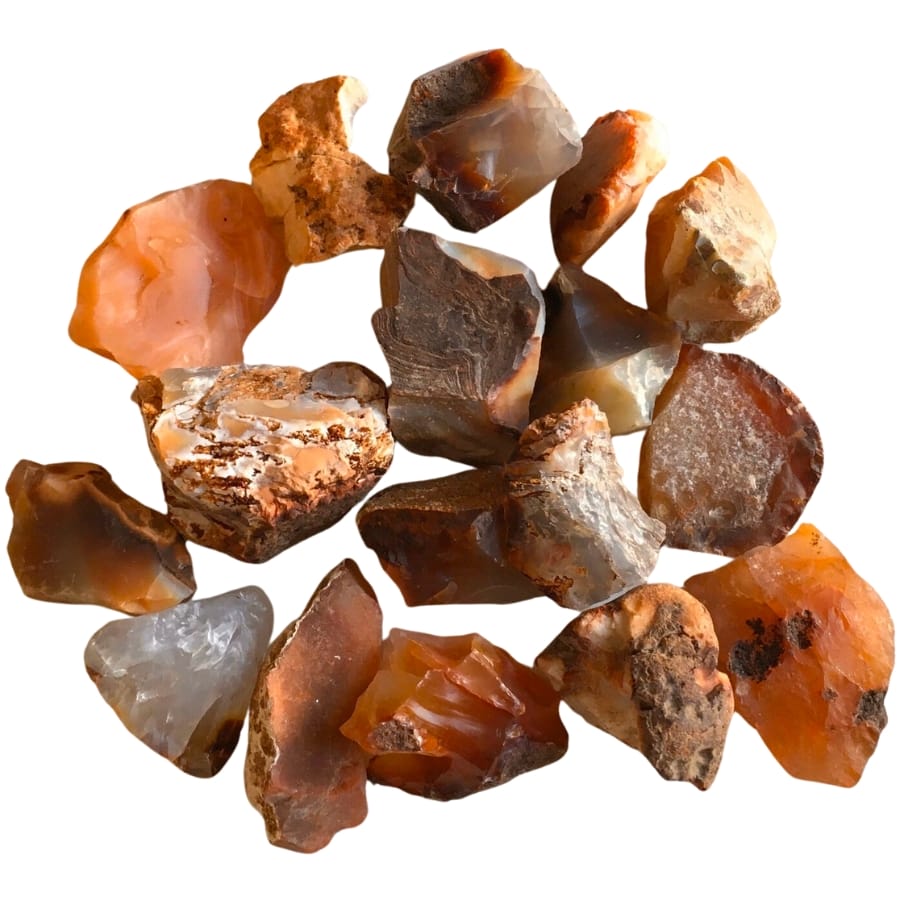
Like agate and jasper, carnelian is a type of quartz. It’s known for its beautiful red, orange, or brown colors. It can range from almost clear to nearly opaque and often has a glassy or slightly waxy look.
It starts with silica-rich rocks. As groundwater moves through these rocks, it dissolves some of the silica. This silica-rich water then gets into spaces in the rock and starts to cool and harden.
If there are iron impurities in the water, they give the carnelian its red or orange color. Carnelian is found in many parts of the world, often in areas with volcanic rocks or places that were once hot and dry.
Regarding the worth of carnelian, it’s valued for a few different reasons. Its warm colors make it a popular choice for jewelry, like rings, necklaces, and bracelets. It can really catch the eye and add a pop of color.
Throughout history, people have also valued it for more than just its beauty. In ancient times, it was believed to bring good luck, protection, and even help calm anger.
Where you can find carnelian in Iowa
Carnelian naturally occurs in many areas of our state, including:
- Black Company gravel operation
- Burlington area gravel-dredging operations and gravel pits
- Molo Sand and Gravel Company
Marcasite
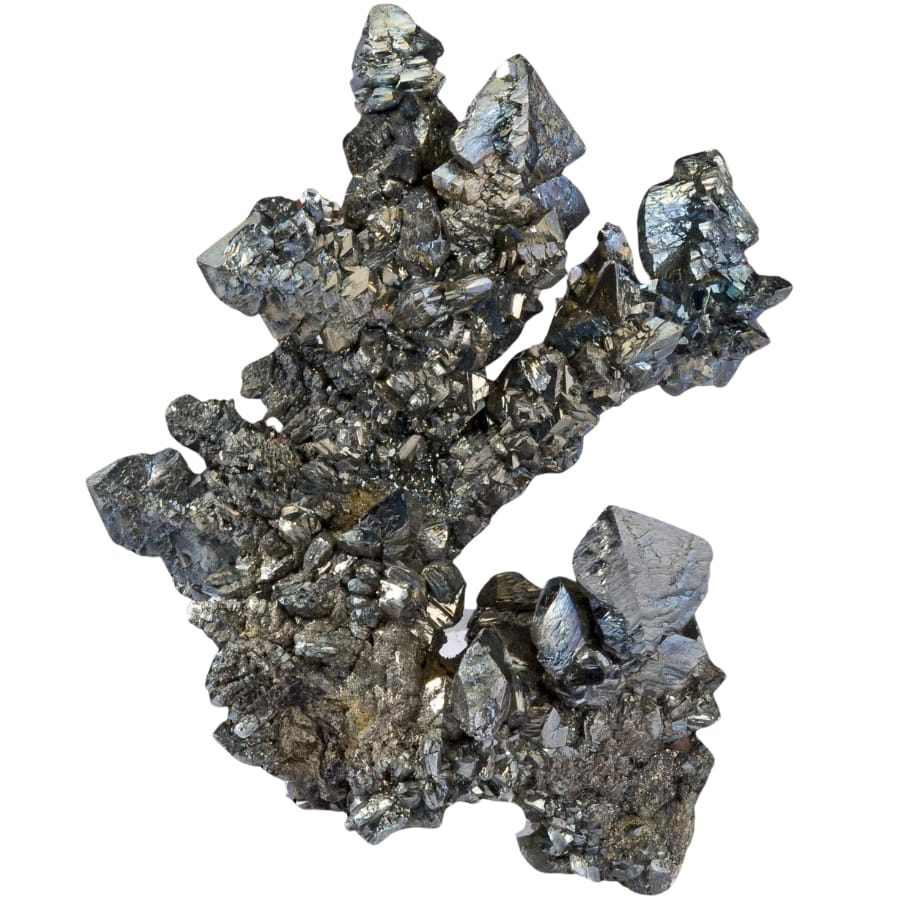
Marcasite is actually iron sulfide, the same as pyrite (which we will discuss more below), but it forms in a different way. It’s usually a pale, brassy yellow color and has a metallic shine.
It forms in sedimentary rocks, like limestone, or in places where there’s a lot of organic material, like coal beds. When iron and sulfur in the ground mix together and react with water, marcasite starts to form.
It can also happen when hot, mineral-rich water flows through cracks in the rocks underground.
Now, the value of marcasite is really interesting. For starters, it’s been used in jewelry for centuries.
People love its sparkly, metallic look, and it’s often cut into small stones for rings, earrings, and necklaces. It has a vintage feel to it that’s really popular in certain styles of jewelry.
Where you can find marcasite in Iowa
There are different spots where you can find marcasite here. Some of them are the following:
- Countywide in Marion County
- Tyrone area coal mine dumps
- Pershing Mine dump
Amethyst
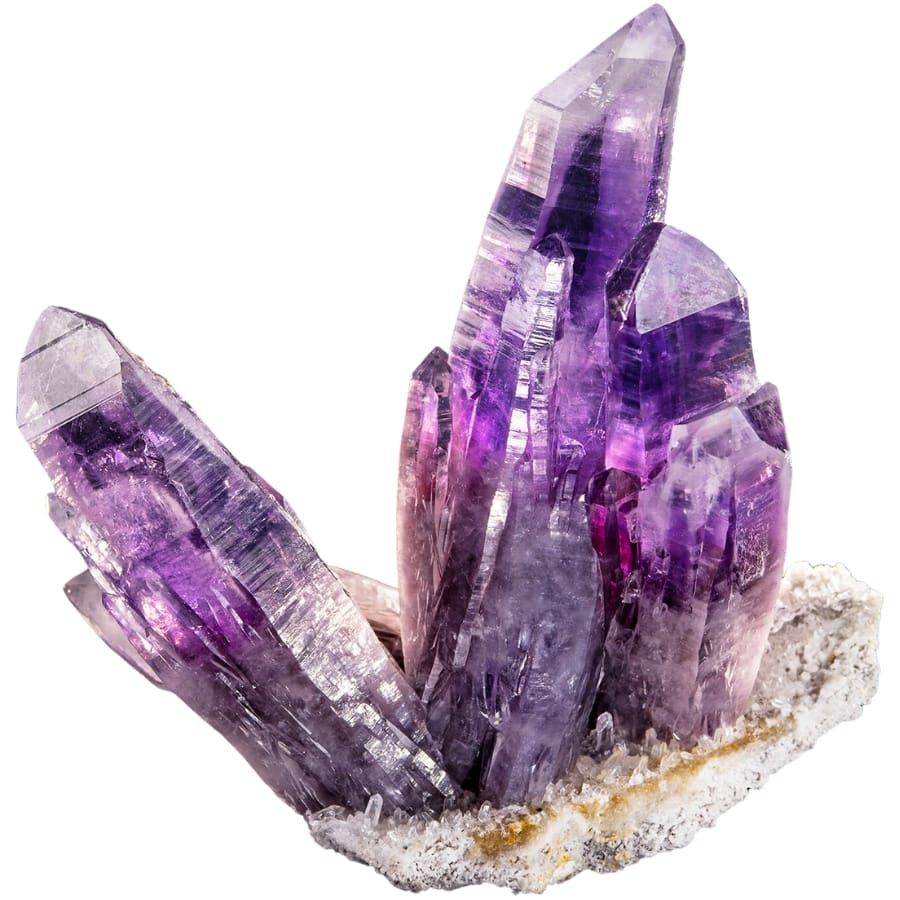
Amethyst is a type of quartz with a stunning purple color. This color can range from a light lavender to a deep, rich purple. Sometimes, you might even see an amethyst with a mix of purple and white.
Its formation all starts deep underground, where there are cavities or pockets in the rocks. These pockets get filled with hot, mineral-rich water. Over time, the minerals in this water start to form crystals.
Quartz is one of these minerals. When it has traces of iron in it and it’s exposed to radiation from the rocks around it, it turns into the purple amethyst we see. This gem is found often in volcanic rocks or areas with a lot of geological activity.
Amethyst’s price is dictated by several factors. Its beauty makes it popular in jewelry. People love wearing this gem in rings, necklaces, and earrings because of its gorgeous color and the way it sparkles in the light.
In history and culture, it’s had a lot of significance, too. Some people believed it could protect them from bad thoughts and help them stay calm and clear-headed.
It’s even been used in royal crowns and jewelry because of its beauty and supposed powers.
Where you can find amethyst in Iowa
You can find sparkling amethysts inside geodes from Keokuk.
The Crystals Found In Iowa
Now, let’s proceed to the different crystals found in Iowa. You’re in luck because our state boasts plenty of these natural wonders. And we’ve prepared a guide that will help you find and uncover them. Check this out!
Calcite
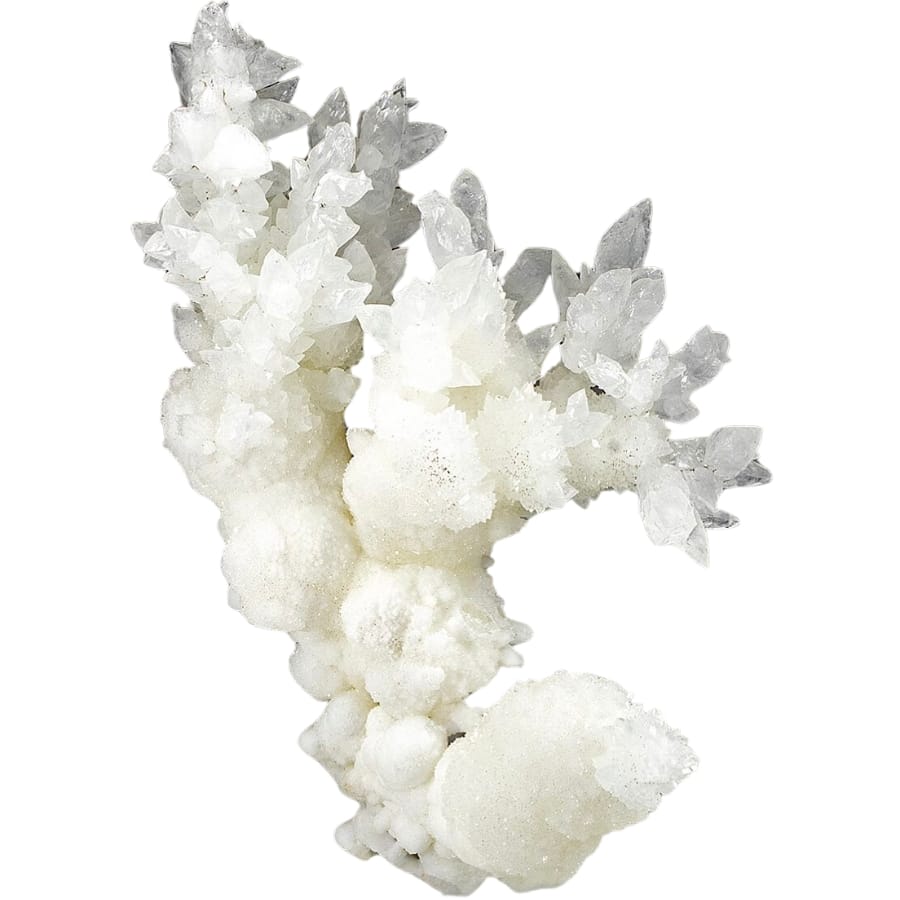
Calcite is a super common crystal. It’s made from calcium carbonate, which is the same stuff in chalk and limestone. It can come in a lot of different colors, like clear, white, pink, blue, and even green.
It often forms in sedimentary rocks or in the shells of sea creatures. When these animals die, their shells pile up on the sea floor. Over time, these shells get packed down and turn into rock. Sometimes, hot water with dissolved minerals can flow through these rocks and form calcite crystals.
Another way it forms is in caves. When water dripping through the roof of a cave evaporates, it leaves behind calcite, which slowly grows into stalactites and stalagmites.
Calcite’s price is heavily influenced by its many uses in a lot of everyday things. It’s ground up to make cement and is also used in things like toothpaste and antacids.
But calcite isn’t just useful; it’s also really mesmerizing. People love collecting different kinds of this crystal because it can form such amazing shapes and colors. It’s also used in jewelry and as decoration.
Where you can find calcite in Iowa
Breathtaking pieces of calcite can be found in many areas here, including:
- Guttenburg area
- Eagle Point Park
- Countywide in Linn County
Chalcedony
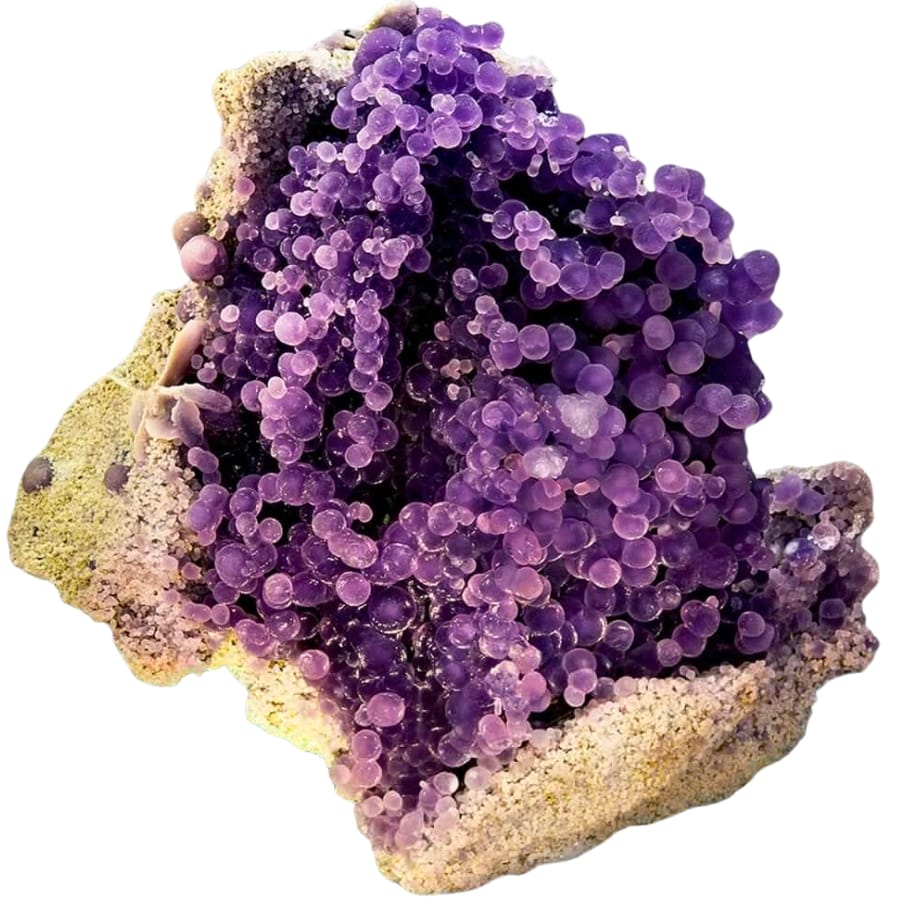
Chalcedony is also a part of the quartz family, but what makes it unique is its looks. It’s not clear like typical quartz, but instead has a waxy, almost soft appearance. It comes in lots of different colors and, sometimes, it’s even multi-colored.
When silica-rich water flows through cracks and spaces in rocks, this crystal starts to form. This water deposits layers of microscopic quartz crystals over time. These layers stack up and eventually form chalcedony.
Chalcedony is found in many places around the world, often in areas with volcanic rocks or old, dried-up riverbeds.
As for chalcedony’s value, it’s often used in jewelry, like necklaces and rings, because it can be cut and polished to show off its colors and patterns.
Aside from its use in jewelry, chalcedony is also interesting for historical and cultural reasons. Different cultures have used it for things like seals and talismans, believing it has protective properties.
Where you can find chalcedony in Iowa
You can find chalcedony crystals inside some Keokuk geodes. You can also find them in other areas, such as:
- Lime Creek and its tributaries
- Bear Creek and its tributaries
- Gravels in Muscatine
Quartz
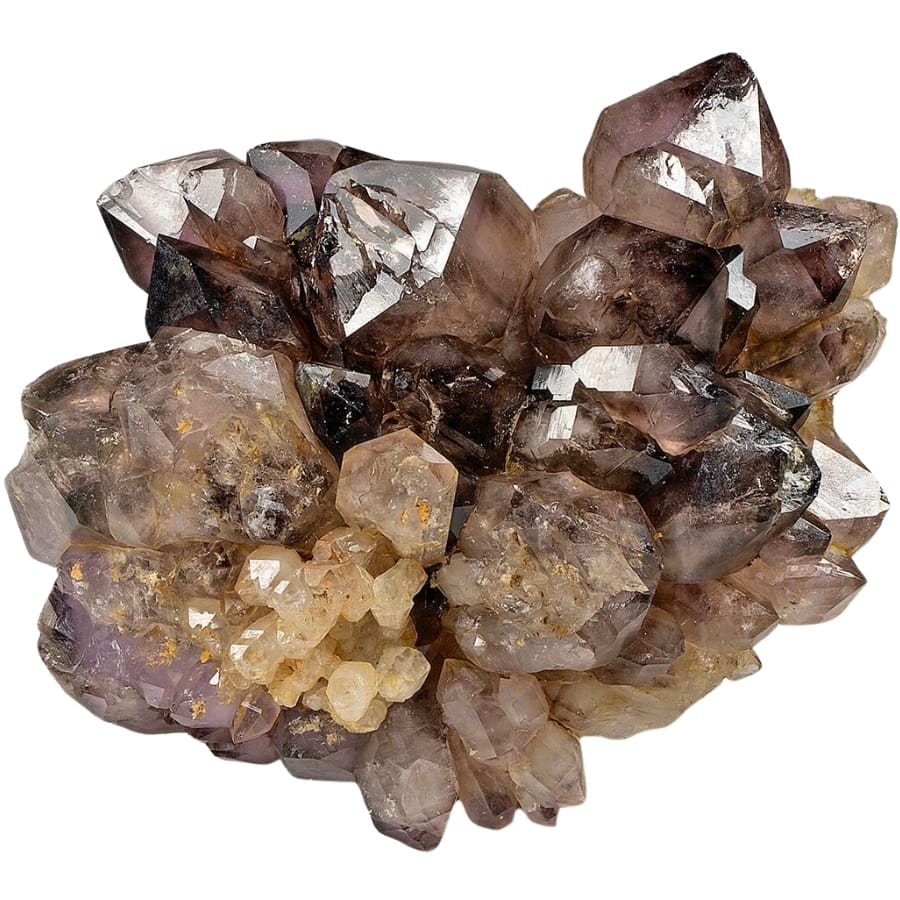
Quartz is found all over the world and is the second most abundant mineral in Earth’s crust. It’s made of silicon and oxygen, and it can come in a lot of different colors, like clear, pink, purple, and even black.
It often starts deep underground. When hot, mineral-rich water cools down, the silicon and oxygen in the water start to stick together and form crystals. This can happen in cracks and spaces in rocks.
These crystals grow into quartz over a long period. Sometimes, this crystal also forms in cooler conditions, like near the surface. That’s why it’s found in many different kinds of rocks, from volcanic rocks to sandstone and even in river beds.
If we talk about the value of quartz, you should know it’s loved for lots of reasons. It’s been used in jewelry for thousands of years because of its appeal and beauty. Some types of quartz, like amethyst and citrine, are especially popular.
Quartz is also used in making glass, concrete, and even electronics like watches and computers. That’s because it can turn pressure or electricity into vibrations.
Where you can find quartz in Iowa
Like chalcedony, quartz is also often found inside Keokuk geodes here. But aside from that, you can also explore the following sites to find quartz:
- Orient area
- Burlington creek gravels
- Muscatine area
Pyrite
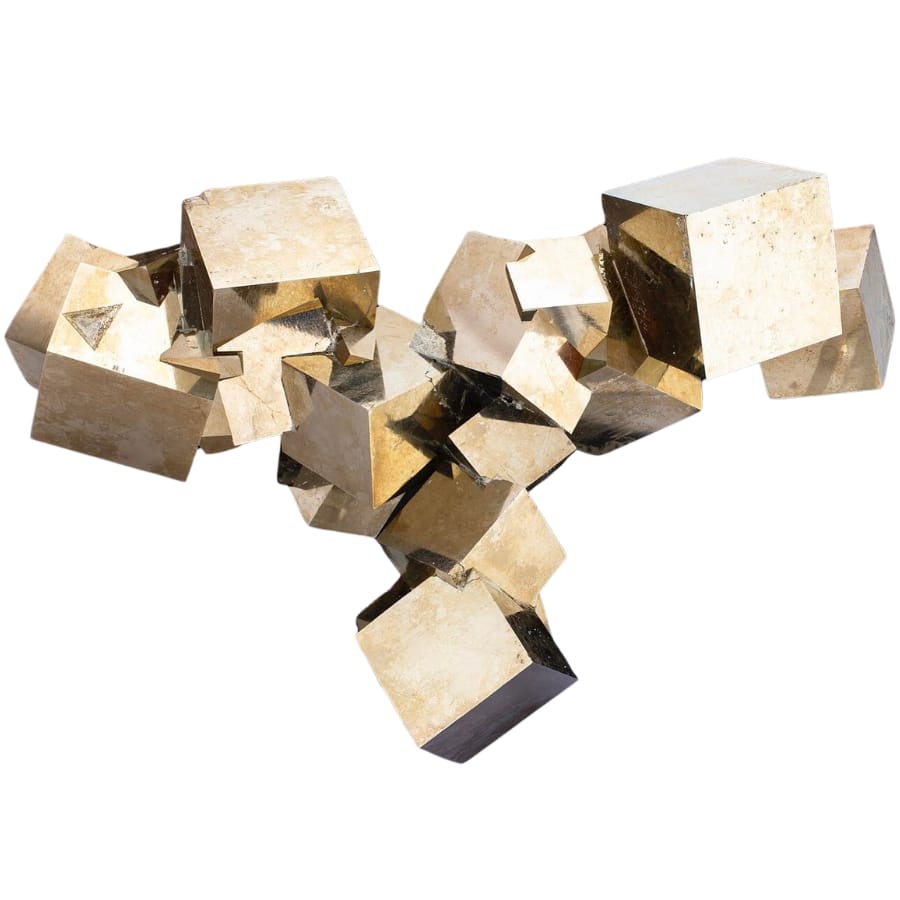
Often called “fool’s gold”, pyrite comes in a shiny, metallic gold color. It’s made of iron and sulfur and often looks like perfect little cubes or other neat geometric shapes.
This crystal forms in places where there’s a lot of sulfur and iron. When these elements mix together in water, they start to form pyrite.
This can happen in a bunch of different environments, like in coal beds, or in rocks that are forming at the bottom of the ocean. Sometimes, pyrite also forms when other types of minerals break down and leave iron and sulfur behind.
Found in many parts of the world, pyrite often forms alongside other minerals like quartz or calcite.
When it comes to the price of pyrite, among the factors that come into play is its uses. Its shiny, metallic look makes it popular for jewelry and decorative items. It’s also a favorite among rock collectors because of its unique crystal shapes.
It also used to be important in industry. It was used to make sulfuric acid, which is used in a lot of different products.
Where you can find pyrite in Iowa
Several areas bear pyrite and these include:
- Coal City coal mine dumps
- County-wide in Appanoose County
- Pershing Mine dump
Selenite
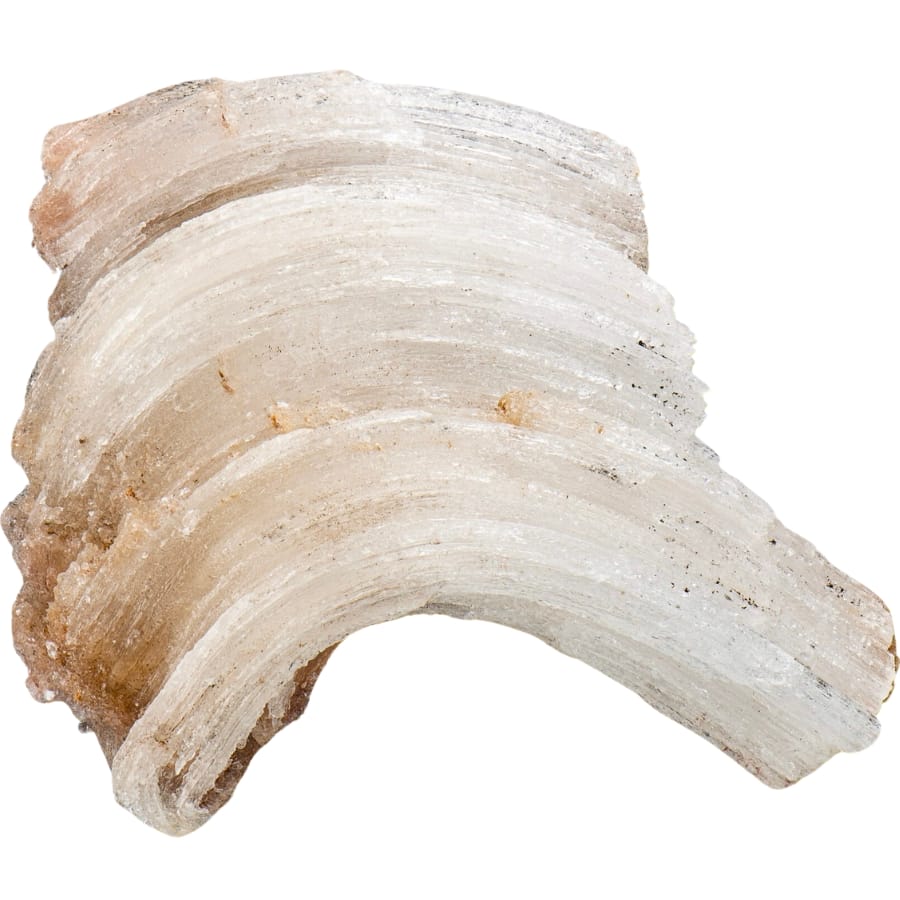
Selenite is a form of gypsum, which means it’s made from calcium sulfate and water. It’s usually clear and can be so shiny and transparent that it almost seems like glass. Sometimes, it also forms in long, flat crystals that look like swords or wands.
It forms in places where there’s evaporating saltwater, like salty lakes or seas. When the water in these places starts to dry up, it leaves behind minerals, including selenite.
This crystal can also form in caves where water drips down and evaporates, leaving the mineral behind. It’s found in many parts of the world, often in dry, desert areas or places with a lot of saltwater.
As for the worth of selenite, its clear, glass-like appearance makes it sought-after for decoration and in jewelry. Some people even use it in their homes for its look and feel.
In history and culture, selenite has also been seen as a special stone. Some people believe it has calming properties and can bring peace and clarity. This has made it popular in various traditions and practices.
Where you can find selenite in Iowa
Among the areas where you can find selenite here are:
- Albia area coal mine dumps
- Brompton area coal mine dumps
- Foster area coal mine dump
Aragonite
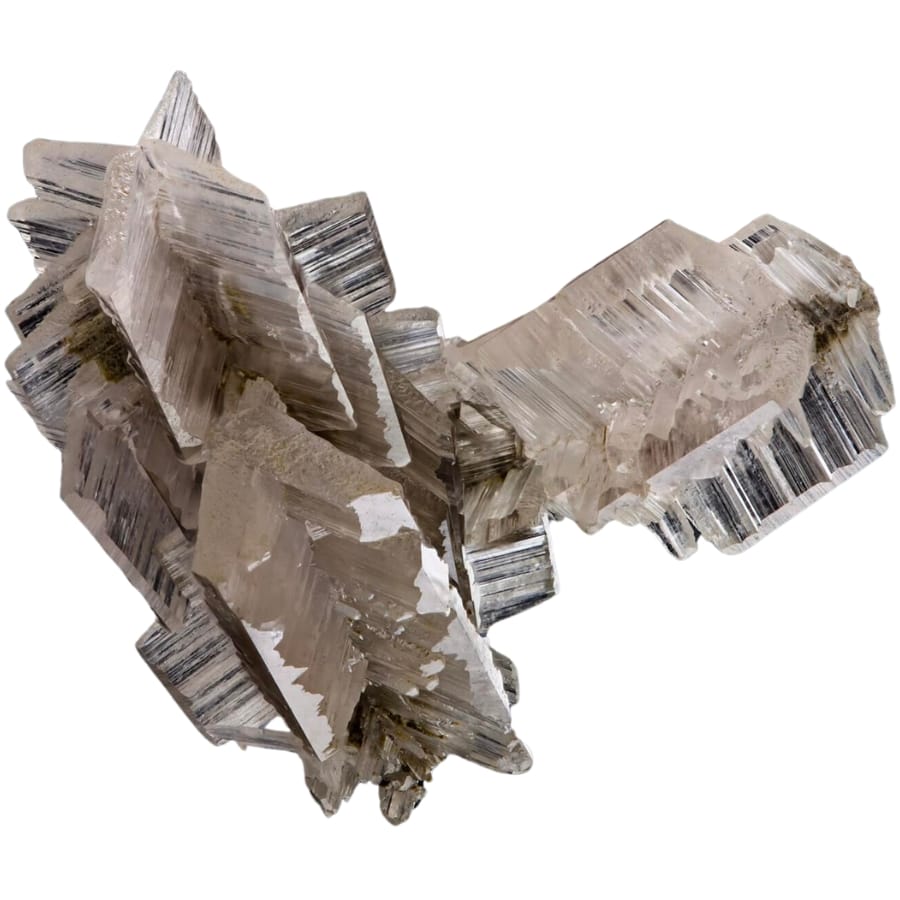
Aragonite is made of calcium carbonate, the same stuff that’s in chalk and limestone. It often looks like a long, pointy needle. It can also form in star or flower-like shapes.
If you’re wondering how aragonite forms, it usually happens in warm, shallow sea waters. When water that’s full of calcium and carbonate mixes, aragonite starts to crystallize.
This can happen on the sea floor, in coral reefs, or inside the shells of some sea creatures like clams and oysters. Aragonite can also form in caves, just like selenite, where dripping water leaves behind minerals.
This crystal is found in lots of places around the world, especially in areas with coral reefs or hot springs.
The unique shapes and sometimes bright colors of aragonite make it popular for jewelry and decorative pieces. It’s also used in aquariums because it can help keep the water healthy for fish.
Aragonite is also important for the environment. It’s a big part of coral reefs, which are super important for ocean life. Reefs provide homes for lots of different sea creatures.
Where you can find aragonite in Iowa
If you want to find aragonite in our state, here are some places that you can explore:
- Crystal Lake Cave
- Wairere Serp Quarry
- Bear Creek
The Most Valuable Rocks and Minerals in Iowa
Now that we’re done with the common rocks, minerals, gemstones, and crystals that we have, let’s proceed to the most valuable ones that you can find in Iowa.
Take note that value is not merely measured by their price tag, but by how appreciated, regarded, and important they are for many.
Sapphire
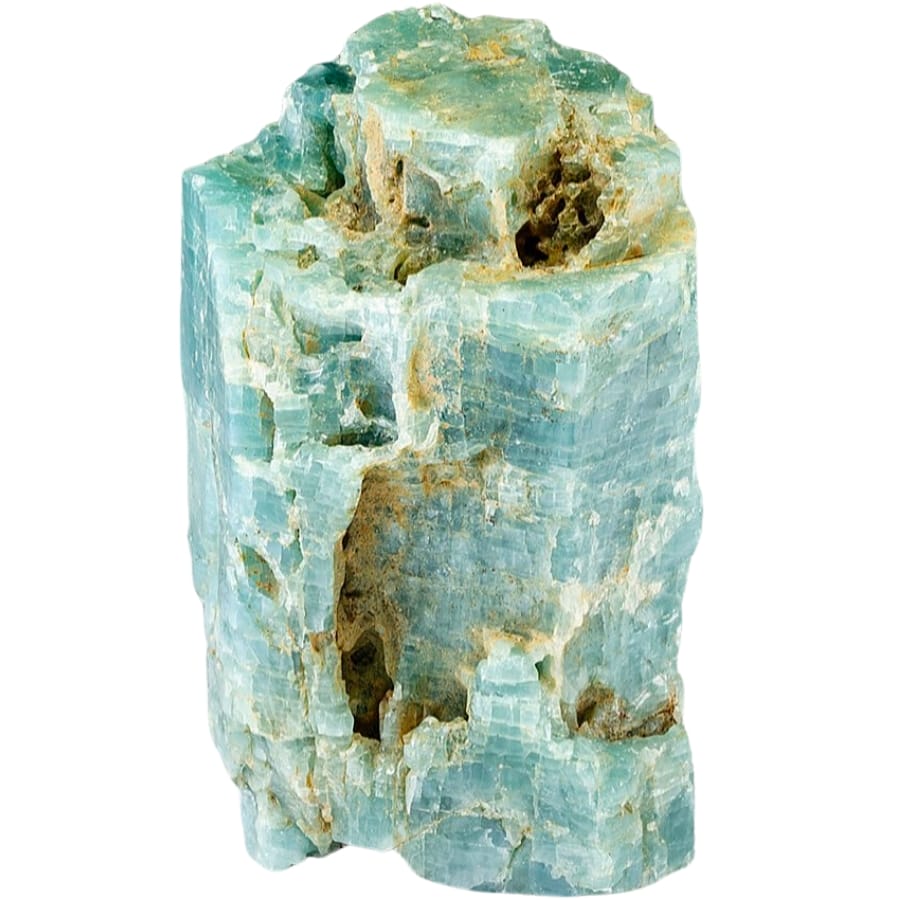
Sapphire is normally known for its stunning blue color. But did you know it can actually come in lots of different colors, like pink, yellow, and even clear? It’s a type of corundum, which is really hard— just behind diamonds on the Moh’s Scale.
It usually develops in places with a lot of heat and pressure, like deep underground or in areas where there’s volcanic activity. The main ingredients for sapphire are aluminum and oxygen.
Sometimes, other elements mix in, like iron or titanium, and that’s what gives it different colors. Sapphires are found in many parts of the world, often in places with ancient volcanic rocks or where the Earth’s crust is really thick.
If you’re curious about the price of sapphire, you can check out our article on that.
But to give you an idea, it’s valued for a bunch of reasons. Its beauty and the way it sparkles make them a top choice for jewelry, like engagement rings and necklaces. The blue sapphires are especially popular and can be really pricey.
Since sapphire is also super tough, it’s useful in some industrial things, like watches and scientific instruments.
Where you can find sapphire in Iowa
You can find fine pieces of gem-quality sapphire along the shoreline of the West Okoboji Lake.
Pearl

Pearls are special because they’re one of the few gems that come from living creatures: oysters and clams! They are known for their beautiful, shiny, smooth surface and can be white, cream, or even have hints of pink and blue.
When a tiny piece of sand or something similar gets inside an oyster or clam, the oyster or clam feels it like a little irritant. To protect itself, the oyster or clam covers this irritant with layers of a shiny substance called nacre.
This is the same stuff that lines the inside of their shells. Over time, these layers build up and form a pearl. That’s why they are often found in oceans, rivers, and lakes.
As a symbol of elegance and class for centuries, the value of pearl can soar. They’re just naturally beautiful. Their shine and smoothness make them perfect for all kinds of jewelry.
They’re also special because each one is unique. No two pearls are exactly the same, which makes them even more special. People also value pearls for their connection to nature and the ocean.
Where you can find pearl in Iowa
Pearl is quite plenty in our state, and if you want to find them, here are some areas you can visit:
- Mississippi River and other rivers, including the Cedar, Wapsipinicon, Maquoketa, Turkey, Iowa, and Skunk, as well as many lakes
- Harper’s Ferry
- Muscatine area
Moonstone
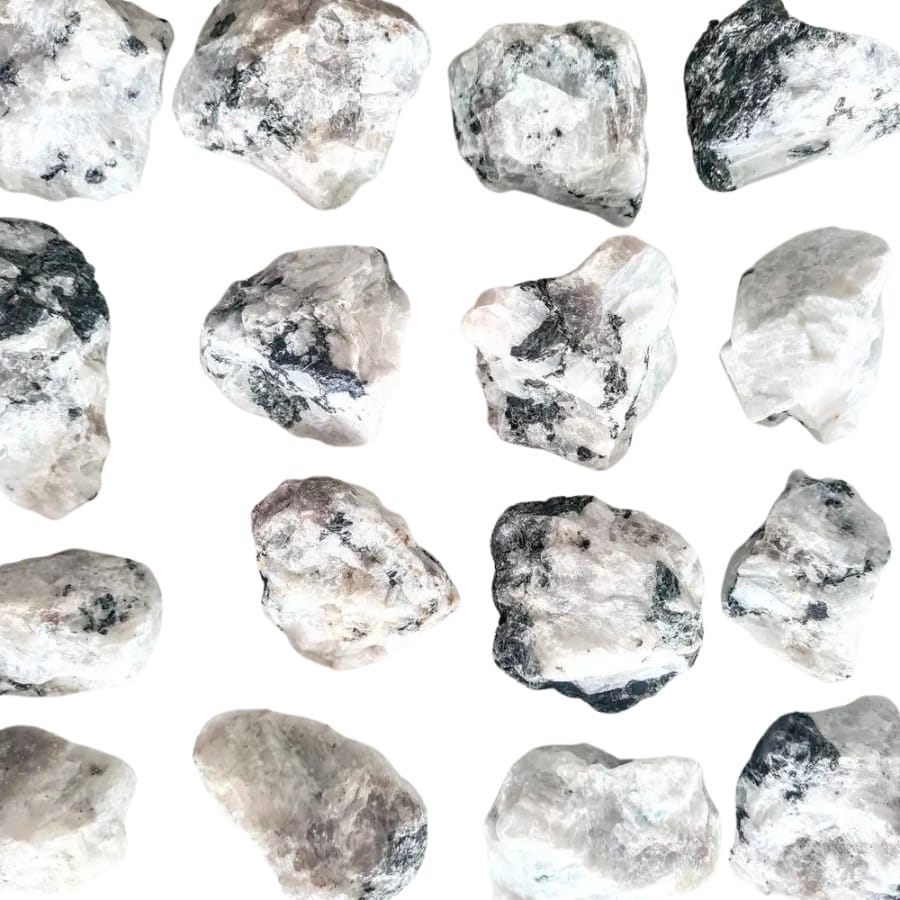
Moonstone is a magical-looking gem that has a special glow. This glow, called adularescence, makes it look like it’s glowing from the inside, kind of like moonlight shining on water. It comes in colors of white, blue, peach, and even black.
It’s part of the feldspar group, which is a type of mineral that makes up a lot of the Earth’s crust. Moonstone forms when two different types of feldspar mix together while they’re still hot and slowly cool down over time.
As they cool, the feldspar separates into thin layers. Light bounces off these layers and creates its glowing effect. Moonstone is found in several parts of the world, like Sri Lanka, India, and, of course, the United States.
You might ask, “Is moonstone expensive?” It really depends. Its value comes from its unique look and the quality of its glow. High-quality moonstones with a clear color and strong glow are usually more valuable and can be quite expensive.
People love this gem not just for its beauty, but also because it has a kind of mysterious and romantic feel to it. It’s been used in jewelry for centuries and is often associated with love and good fortune.
Where you can find moonstone in Iowa
Despite being valuable, moonstone is pretty abundant in our state. Some of the areas where you can find them are:
- Dubuque area gravels
- Along the Mississippi River in Bellevue
- Hahn Brothers Gravel Company
How to Identify The Rocks and Minerals You Find
Say you’re already exploring our state and found different rocks, but are unsure what they are exactly. How do you identify them?
Below are some very useful tips that will help you identify your rocks by delving into their specific properties.
Observe the color
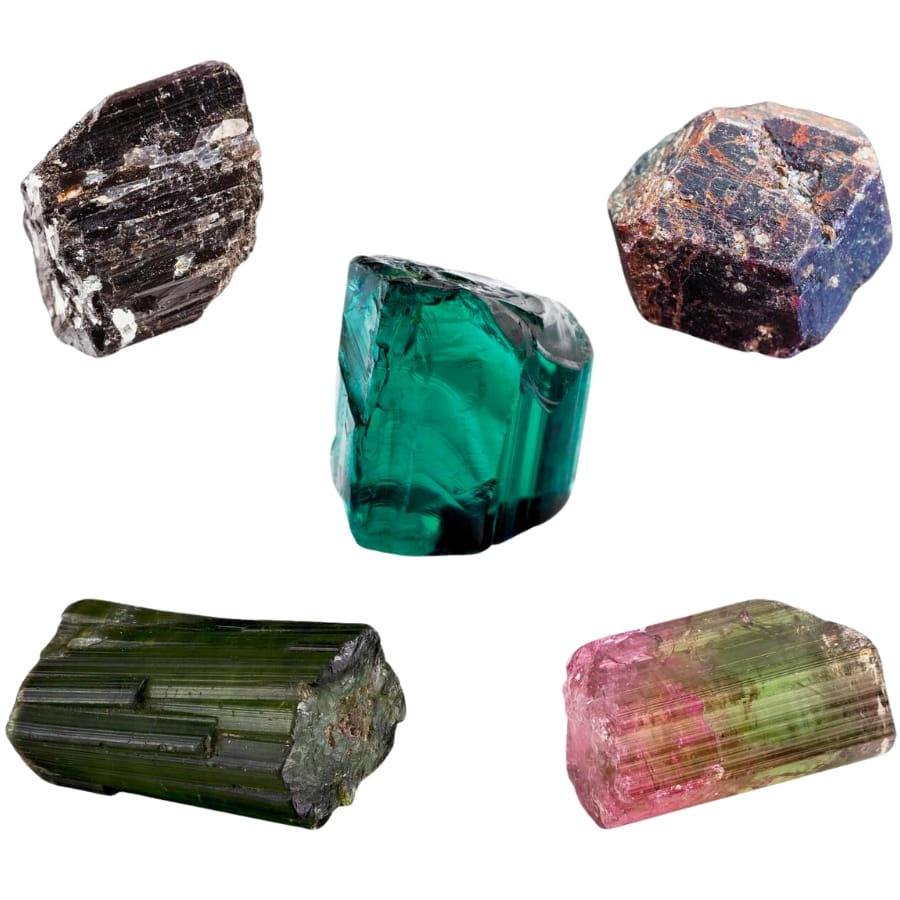
Simply examine the overall hue and any variations of the specimen in good light. Note whether the color is uniform or if it includes streaks, spots, or bands of different colors.
Keep in mind that the surface color might be affected by weathering or impurities, so it may not always be the true indicator of the mineral’s identity.
Despite this limitation, color observation can be a helpful first step in rock identification. It narrows down the possibilities, especially when combined with other methods.
Assess the luster
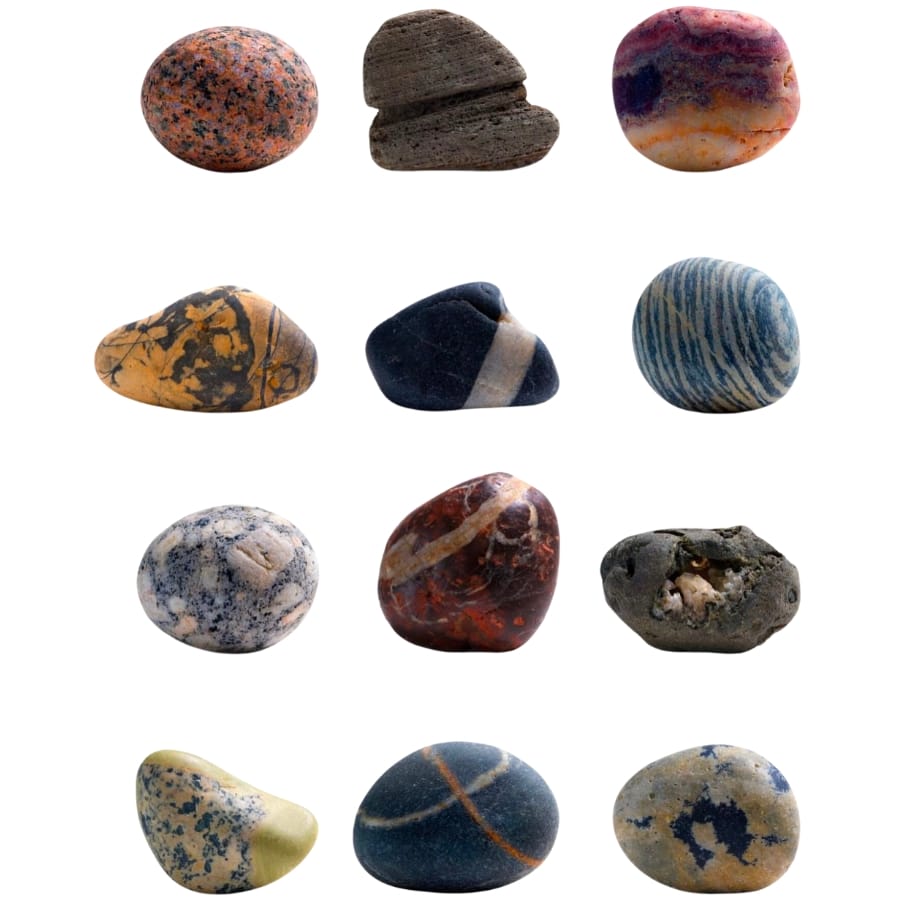
Luster is how a rock or mineral shines when light hits it. To check it, hold your specimen in the light and look at how it reflects the light. There are different kinds of luster.
If it shines like metal, that’s called “metallic” luster. If it looks more like glass, that’s “glassy” or “vitreous” luster. Some don’t shine much at all— that’s a “dull” luster. And if it’s kind of shiny like a pearl or the inside of a shell, that’s “pearly” luster.
Knowing the luster helps you figure out what your rock or mineral might be. For example, if it has a metallic luster, it could be a metal ore like pyrite. But remember, luster is just one clue.
Do a scratch test
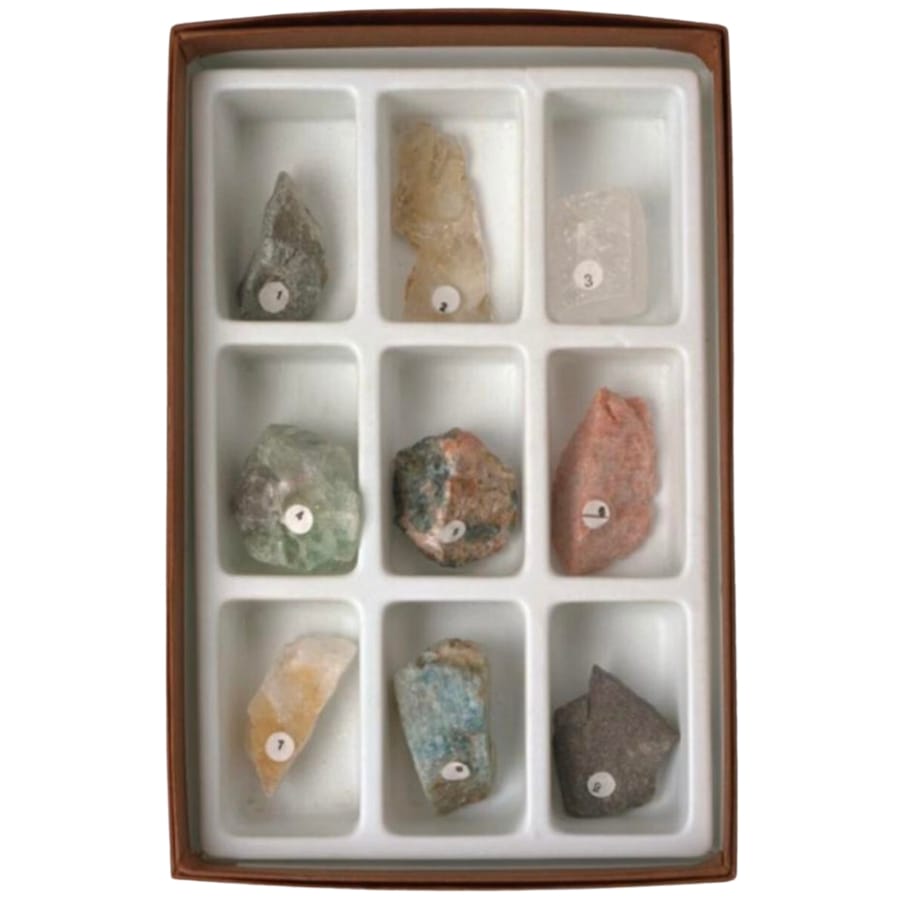
In a scratch test, you use the Mohs Hardness Scale, which is a list from 1 to 10, where 1 is the softest and 10 is the hardest, like a diamond.
Here’s how you do it: Try to scratch your rock with different things like your fingernail (which is about a 2.5 on the scale), a penny (about a 3), or a steel nail (about a 5.5).
If the item scratches the rock, the rock is softer than the item. If it doesn’t, the rock is harder.
This test can help you narrow down the possibilities and get one step closer to identifying your rock. For example, if a penny can’t scratch it, but a nail can, your rock is between 3 and 5.5 on the hardness scale.
Try a streak test
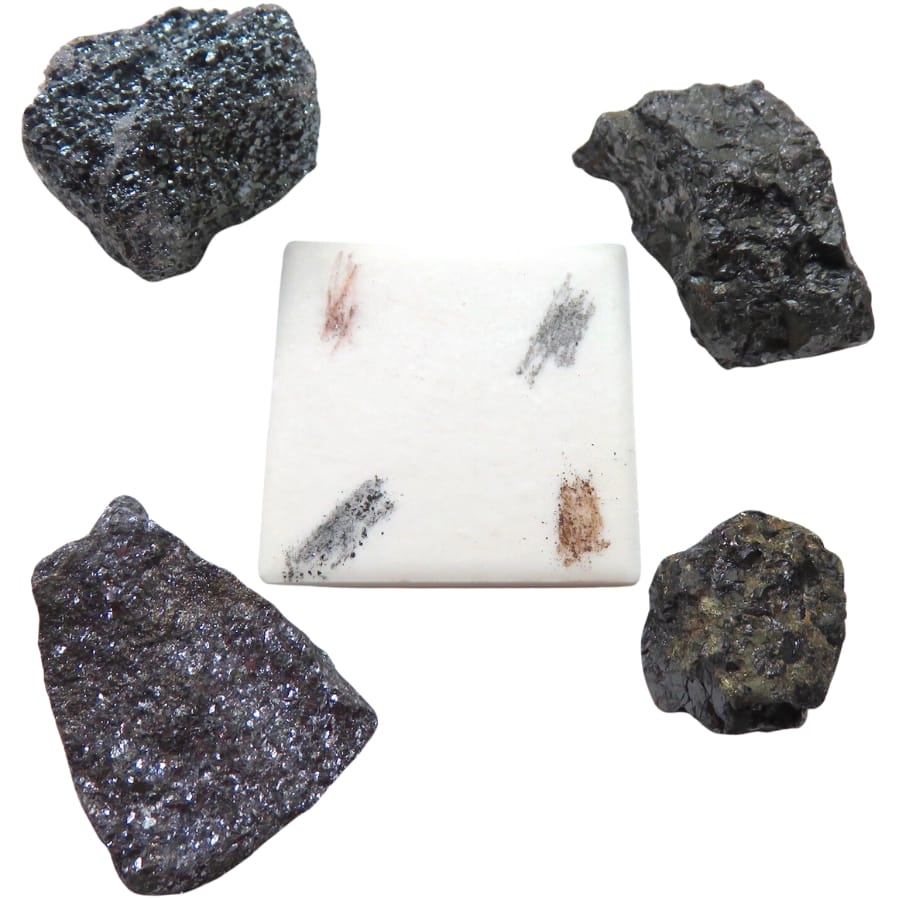
For this test, you’ll need a piece of unglazed porcelain called a streak plate. Rub your rock or mineral across this plate. Don’t worry, it’s not about how strong you are; a gentle rub is just fine.
What you’re looking for is the color of the powder that comes off the rock. This color is called the streak. This test shows the real color of the mineral, which can be different from the color you see on the outside.
This helps a lot in figuring out what the mineral is. For example, even if a piece of hematite looks black or silver, its streak is always reddish-brown. So, if you get a reddish-brown streak, you might have found hematite.
See if it fluoresces
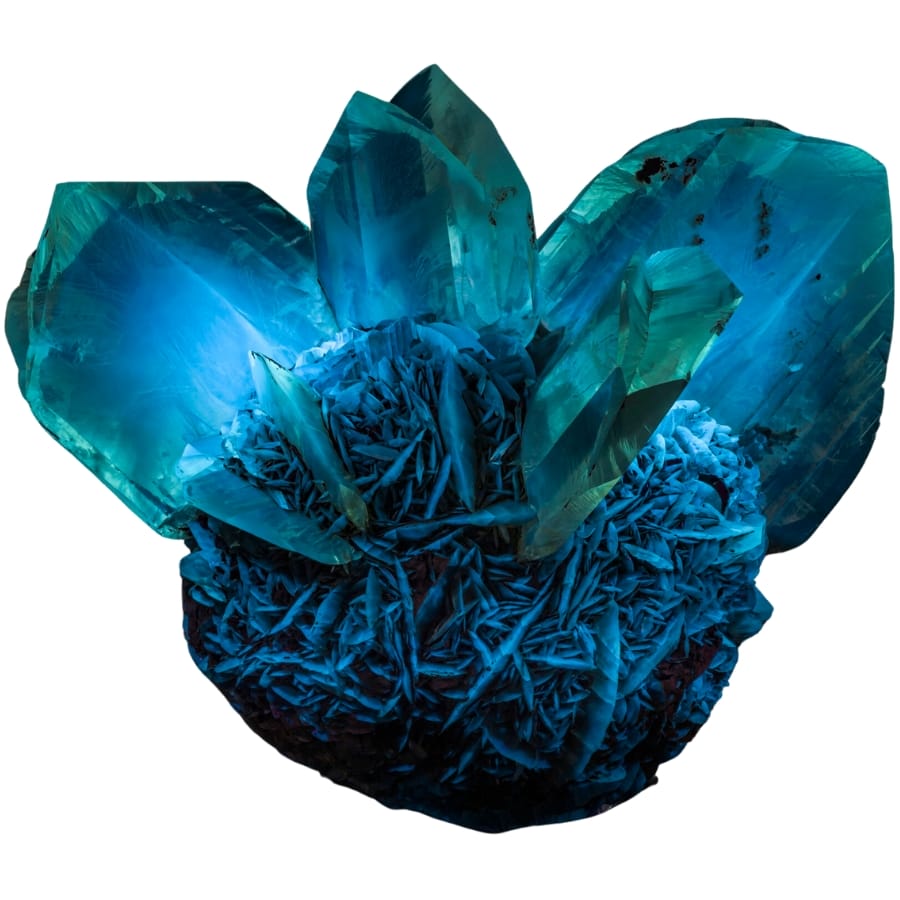
Checking if a rock or mineral glows, or “fluoresces,” under a special light is a fun way to learn more about it. To do this, you need UV light, which is a special kind of light that makes some rocks and minerals light up in cool colors.
Go into a dark room and shine the UV light on your specimen. If it glows, that means it fluoresces.
This glow can help you figure out what kind of rock or mineral you have. Different minerals glow in different colors. For example, the mineral fluorite can glow in bright colors like blue, green, or purple under UV light.
Remember, though, that not all rocks or minerals will glow, and this is another clue for your rock identification.

